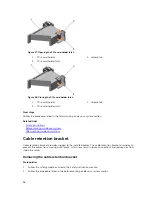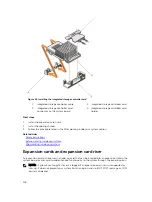
Expansion card installation guidelines
Depending on your system configuration, the following PCI Express (PCIe) generation 3 expansion cards
are supported:
Table 32. Supported expansion cards
PCIe slot Riser
Processor
connection
Height
Length
Link
width
Slot width
1
1
Processor 2
Low Profile
Half Length
x8
x16
2
1
Processor 2
Low Profile
Half Length
x8
x16
3
1
Processor 2
Low Profile
Half Length
x8
x16
4
2
Processor 2
Full Height
Full Length
x16
x16
5
2
Processor 1
Full Height
Full Length
x8
x16
6
3 (alternate)
Processor 1
Full Height
Full Length
x16
x16
NOTE: To use PCIe slots 1 through 4 on the risers 1 and 2, both the processors must be installed.
NOTE: The expansion card slots are not hot-swappable.
The following table provides guidelines for installing expansion cards to ensure proper cooling and
mechanical fit. The expansion cards with the highest priority should be installed first using the slot priority
indicated. All the other expansion cards should be installed in the card priority and slot priority order.
Table 33. Expansion card installation order
Card priority
Card type
Slot priority
Max allowed
1
PCIe Bridge
4
1
2
RAID H730P (low profile)
3, 2
1
3
RAID H830
6, 4, 5
2
RAID H830 (low profile)
3, 2
2
4
100G Intel Omni-Path Architecture
(OPA) Host Channel Adapters (HCA)
4, 6
2
14 Gb InfiniBand, Fourteen Data Rate
(FDR) HCA
3, 2, 1
3
40 Gb NICs (full height)
4, 6, 5
3
40 Gb NICs (low profile)
3, 2, 1
3
5
FC16 HBA (full height)
4, 6, 5
3
FC16 HBA (low profile)
2, 3, 1
3
6
10 Gb NICs (full height)
4, 6, 5
3
10 Gb NICs (low profile)
2, 3, 1
3
7
FC8 HBA (full height)
4, 6, 5
3
105
















































